IoT Solutions: Creating Value for Businesses
The Internet of Things, or IoT, is no longer just an emerging trend. It is a rapidly growing technology that is transforming how companies operate, innovate, and interact with their systems and customers. IoT solutions are now present in a wide range of sectors, from industry to agriculture, including smart cities, energy, healthcare, and logistics. The impact is clear: more efficiency, more actionable data, less waste, and much smarter decisions.
In this article, we explain what really lies behind an IoT solution, how it can be applied in business contexts, which technical decisions are critical, and why choosing the right partner can be decisive for the success of the project.
What exactly does an IoT solution mean?
An IoT solution goes far beyond just putting a sensor online. In practice, it is a complete technological ecosystem, made up of various elements that work together to create value. It all starts with the hardware: physical devices equipped with sensors, actuators, and microcontrollers that collect data from the environment, perform actions, or respond to commands.
These devices are connected through connectivity technologies suitable for the context and the application’s requirements, such as Wi-Fi, Wi-Fi HaLow, mobile networks like 4G or 5G, long-range protocols like LoRa or NB-IoT, Z-Wave, or even Bluetooth Low Energy for short-range communications.
Then, there is the entire support infrastructure, which can be cloud-based or edge computing-based, where data is collected, processed, and prepared for visualization or integration with other systems. This structure includes management platforms that provide real-time dashboards, alerts, APIs, automation rules, and custom reports.
Security is a critical component of any IoT solution, requiring end-to-end data encryption, robust authentication, secure remote update capabilities, and, in many cases, physical protection of the devices.
At the end of it all, the main goal remains clear: to solve concrete business problems. Whether increasing operational efficiency, anticipating failures, improving customer experience, or creating new products and services with added value, well-designed IoT solutions are a strategic lever for any organization.
Use cases with business impact
The practical applications of IoT solutions are extremely varied. In industry, it is common to see sensors installed on machines to monitor their performance, predict failures, and reduce downtime. In energy environments, smart meters and leak detection systems are used to optimize consumption and ensure greater sustainability.
In smart cities, IoT systems allow for automatic adjustment of public lighting, real-time traffic management, and optimization of waste collection. In the agricultural sector, it is possible to monitor soil moisture, control irrigation, and closely track crop development. In healthcare, wearable devices enable remote patient monitoring and improve response to critical situations.
In all these cases, the connection between the physical and digital worlds allows action based on real data, making processes more efficient, safer, and more adaptable.
Technical decisions that influence project success
Developing a robust IoT solution requires strategic choices right from the start. One of the most important is selecting the communication technology. Wi-Fi is not always the best option, especially in industrial environments or rural areas. In many cases, technologies such as LoRa, NB-IoT, or Zigbee offer greater autonomy, range, and reliability.
Another key point is the choice between processing data locally or in the cloud. Edge computing allows for reduced latency and increased privacy, while also decreasing the volume of data sent to remote servers.
It is also crucial to ensure interoperability with other systems through well-supported protocols like MQTT, CoAP, or REST. This facilitates the integration of the IoT solution with existing platforms and reduces dependence on specific vendors.
Finally, cybersecurity cannot be treated as an additional layer. It must be considered from day one, with best practices such as certificate-based authentication, strong encryption, firewalls, OTA updates, and continuous monitoring.
Underestimating these aspects can compromise the project’s viability, especially when aiming to scale the solution or apply it in critical environments.
The role of custom hardware in IoT solutions
Not all applications can rely on generic development boards or ready-to-use solutions. In demanding environments such as factories, clinics, or outdoor areas, it is essential to ensure that the hardware is resistant, energy-efficient, and designed to operate exactly under the expected conditions.
Another advantage of specialized hardware is that generic development boards do not always offer the necessary functionalities or are sometimes overloaded with unnecessary features.
Companies like Detus specialize in developing this type of custom electronic hardware. From circuit design to prototyping and testing, they help engineering and product teams transform ideas into intelligent devices ready for production and integration.
This type of approach allows performance optimization, reduced large-scale production costs, increased reliability, and ensures that the product perfectly adapts to its use context.
Evaluating the return on investment (ROI) in IoT
Implementing an IoT solution represents a strategic investment. And like any investment, it must be analyzed in terms of return. Some metrics help to understand the real impact:
- Reduction of unexpected breakdowns and technical downtimes
- Energy savings through monitoring and automation
- Increase in operational productivity
- Reduction in response time to failures or alerts
- Creation of new revenue streams through interconnected products
- Improved decision-making based on real-time data
The true value of IoT lies in the ability to anticipate, adjust, and act before problems occur. Those who master the data of their ecosystem have a clear competitive advantage.
The future is smart, connected, and integrated
As companies evolve, IoT is no longer a risky bet but becomes a basic infrastructure. The trend points to convergence with artificial intelligence, machine learning, and 5G, which will enable even more powerful, autonomous, and intelligent solutions.
Those who invest now, in a structured way, with specialized partners and a focus on results, will be at the forefront of innovation.
If you have a project where connectivity can make a difference, whether in developing a new product or modernizing an existing system, Detus can help.
